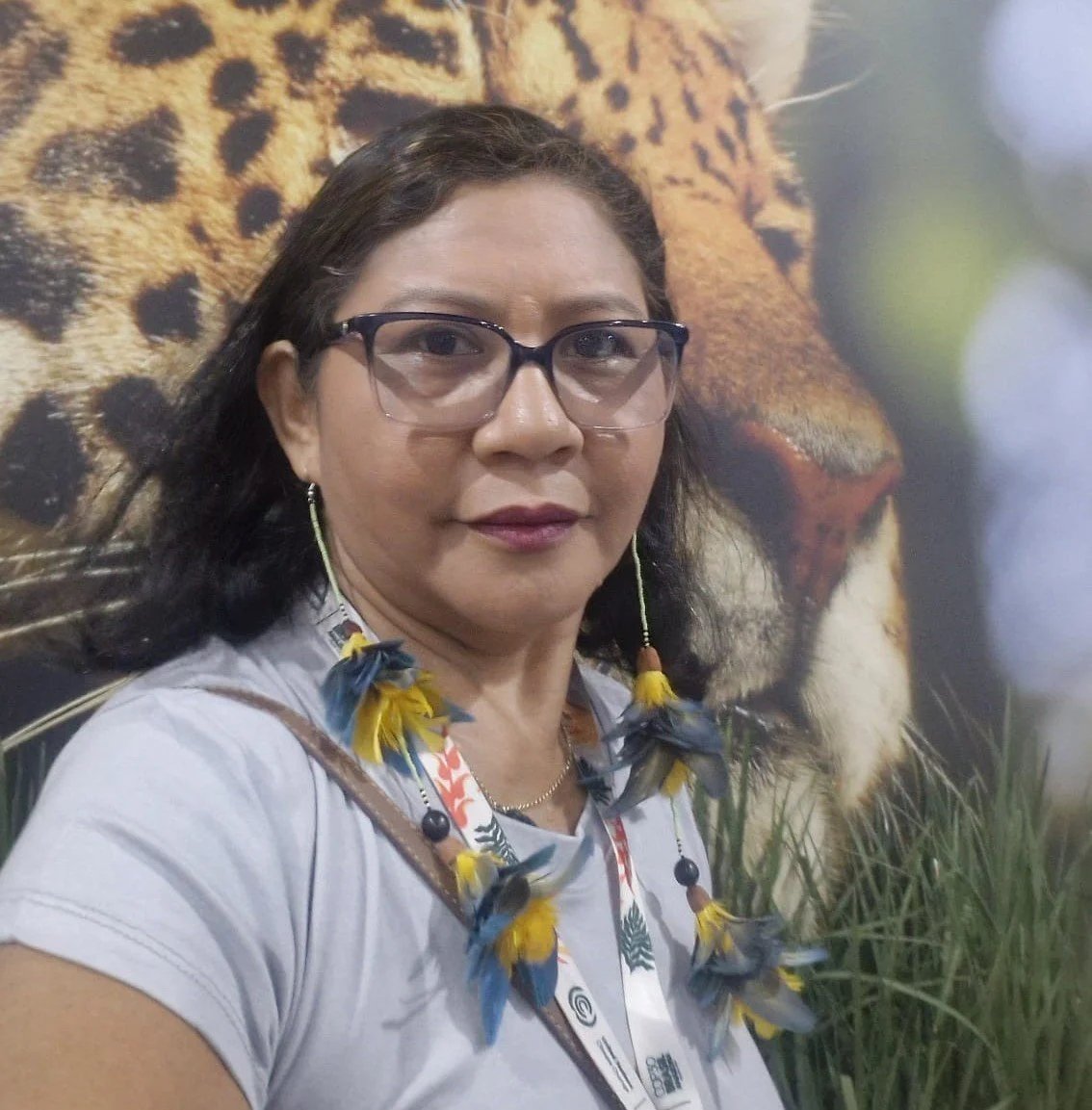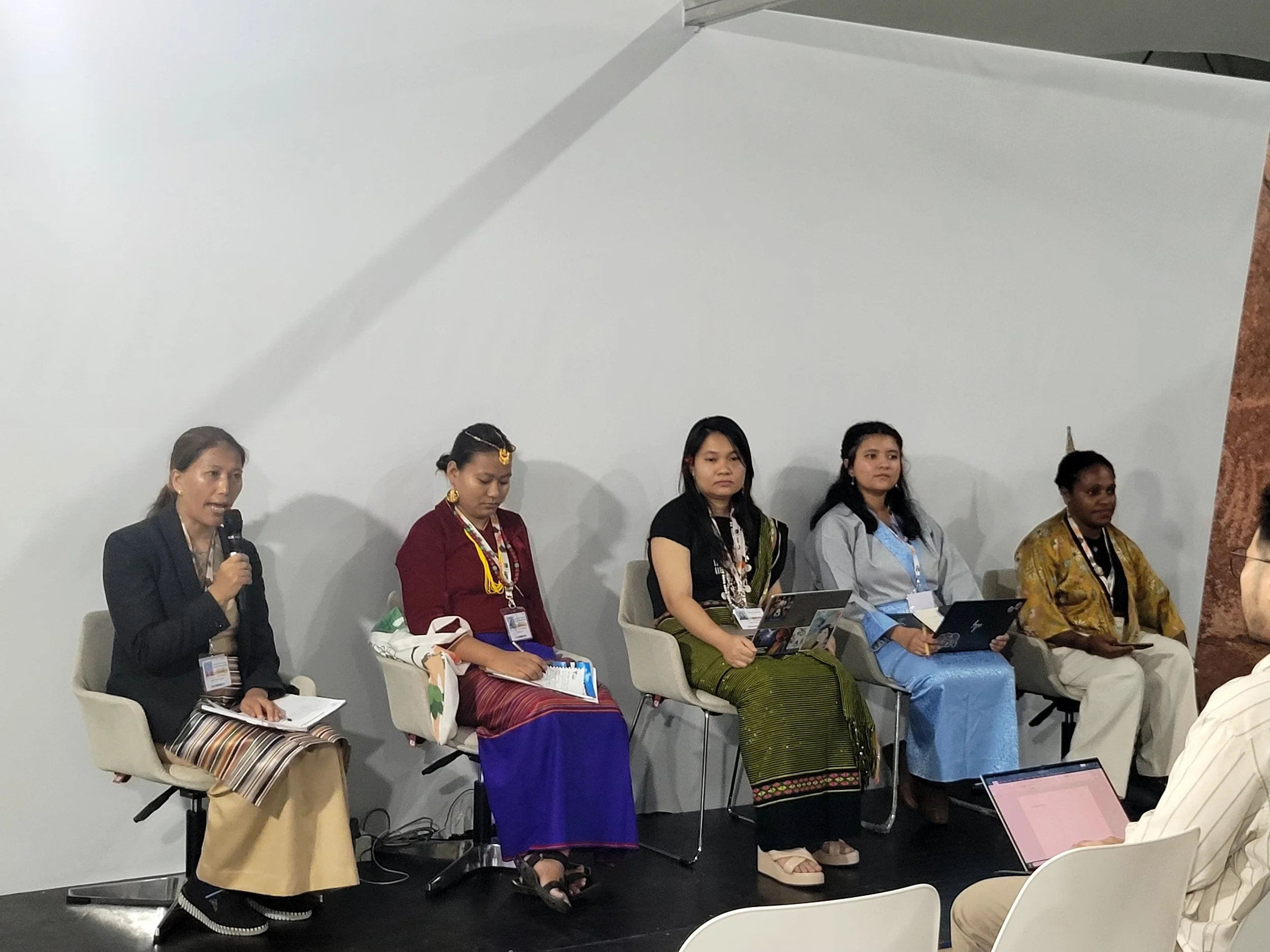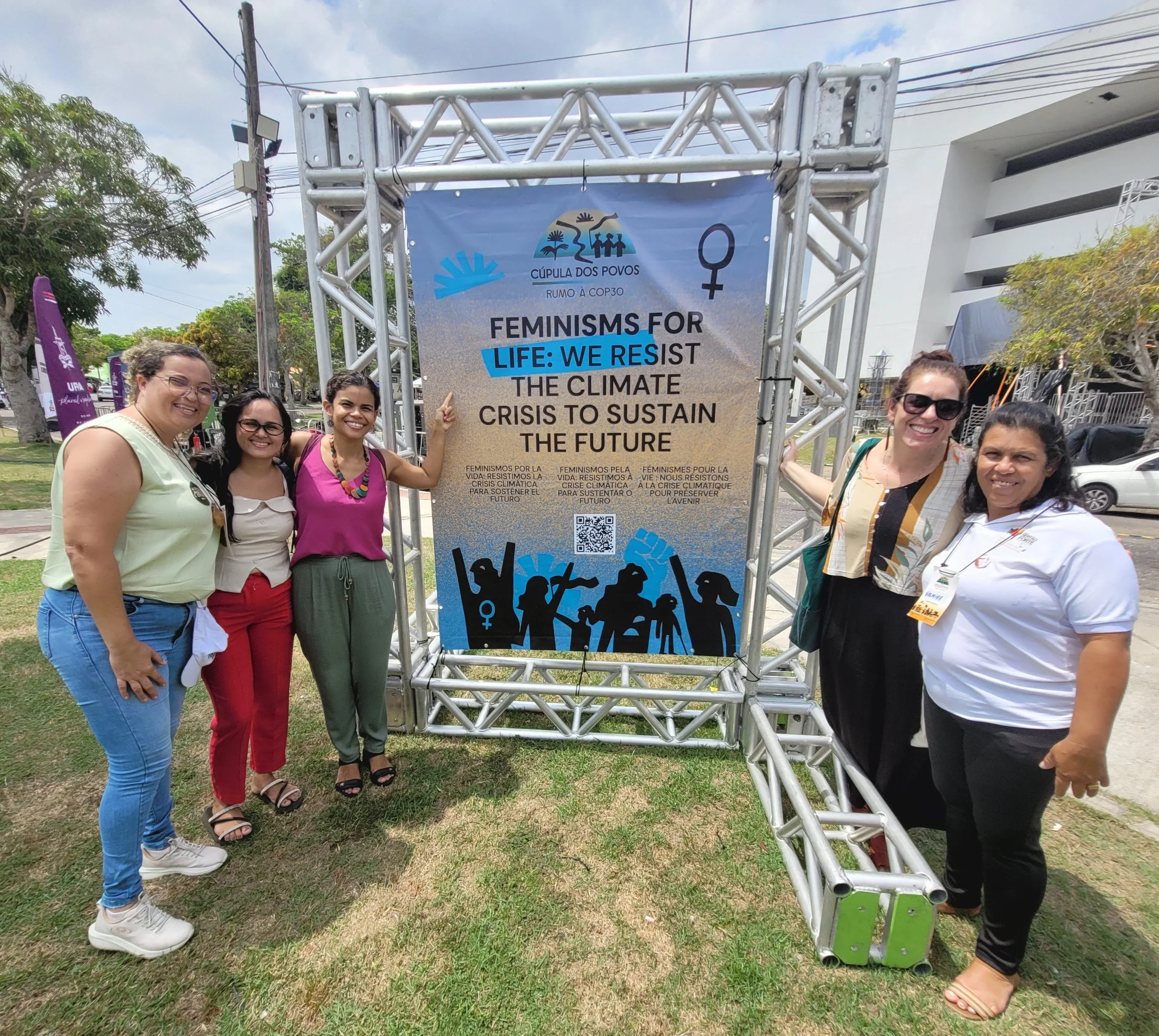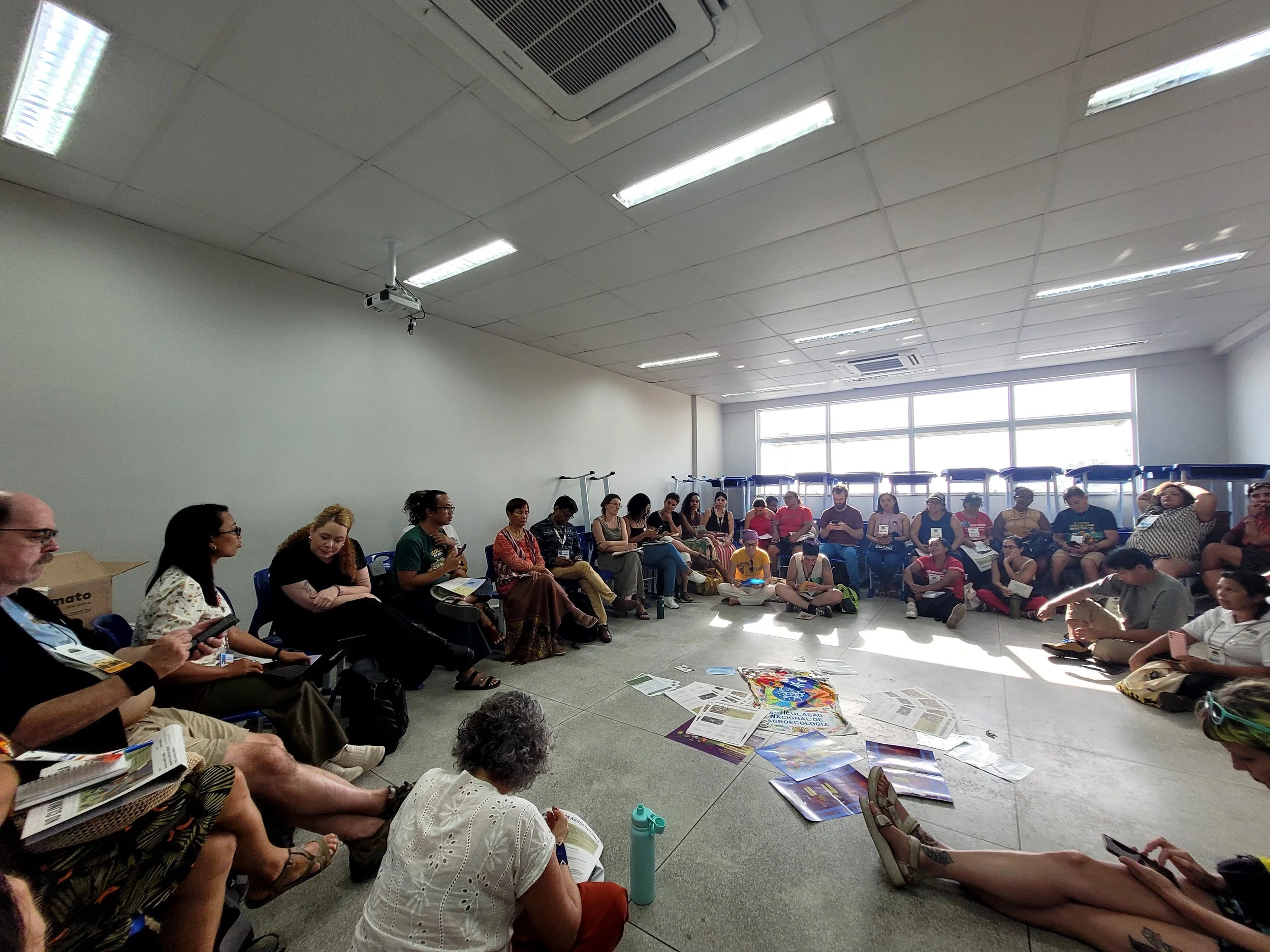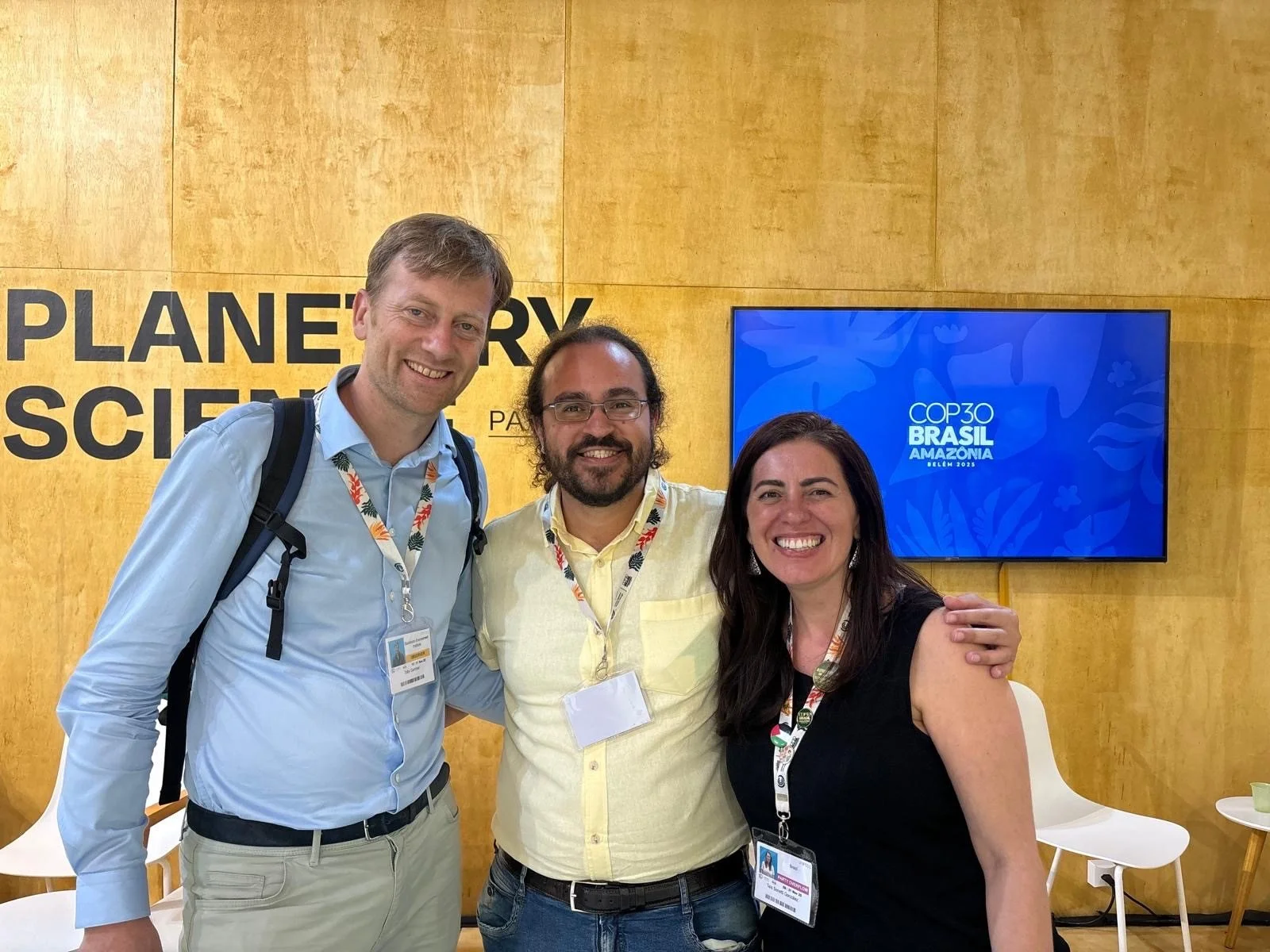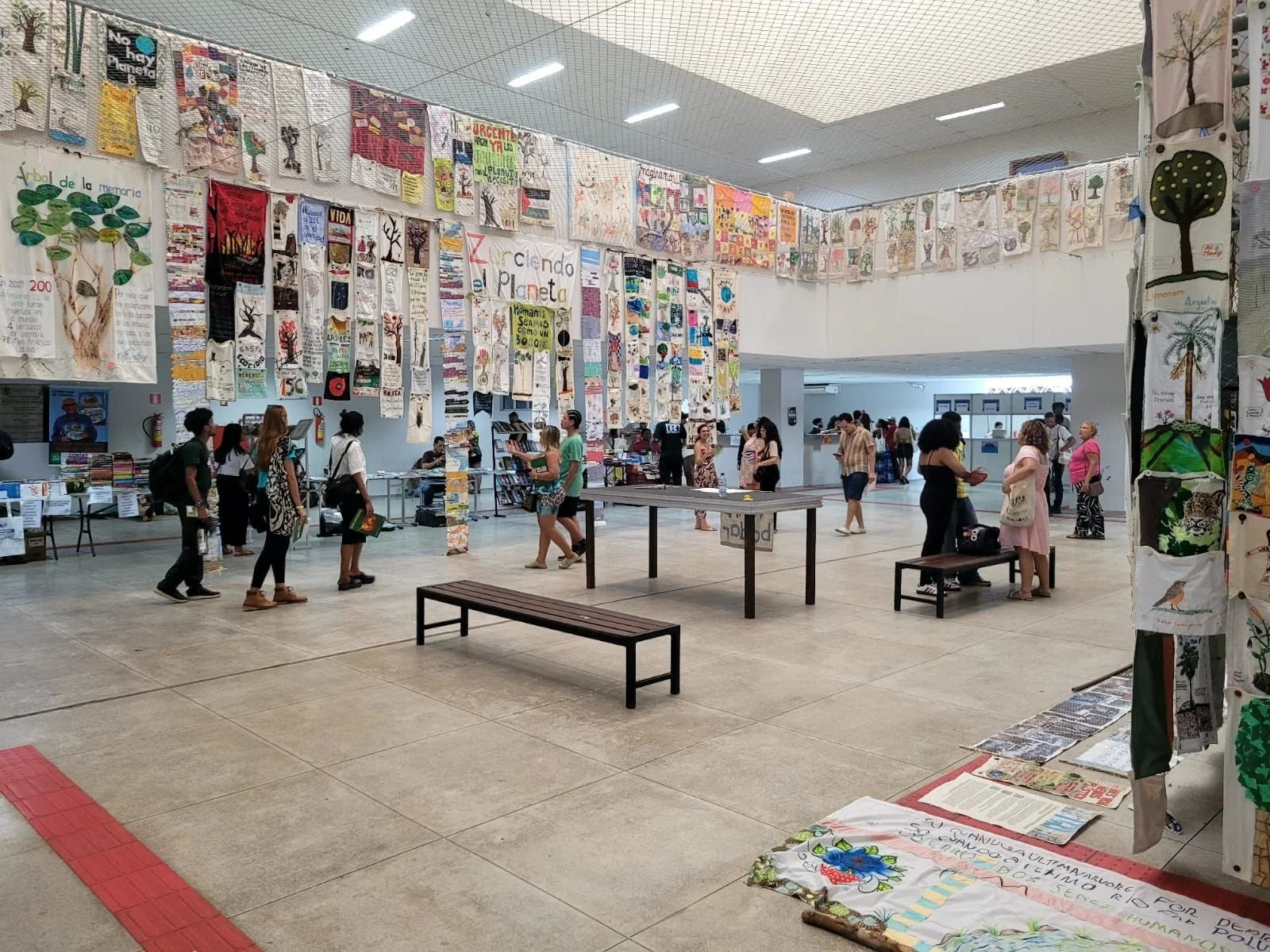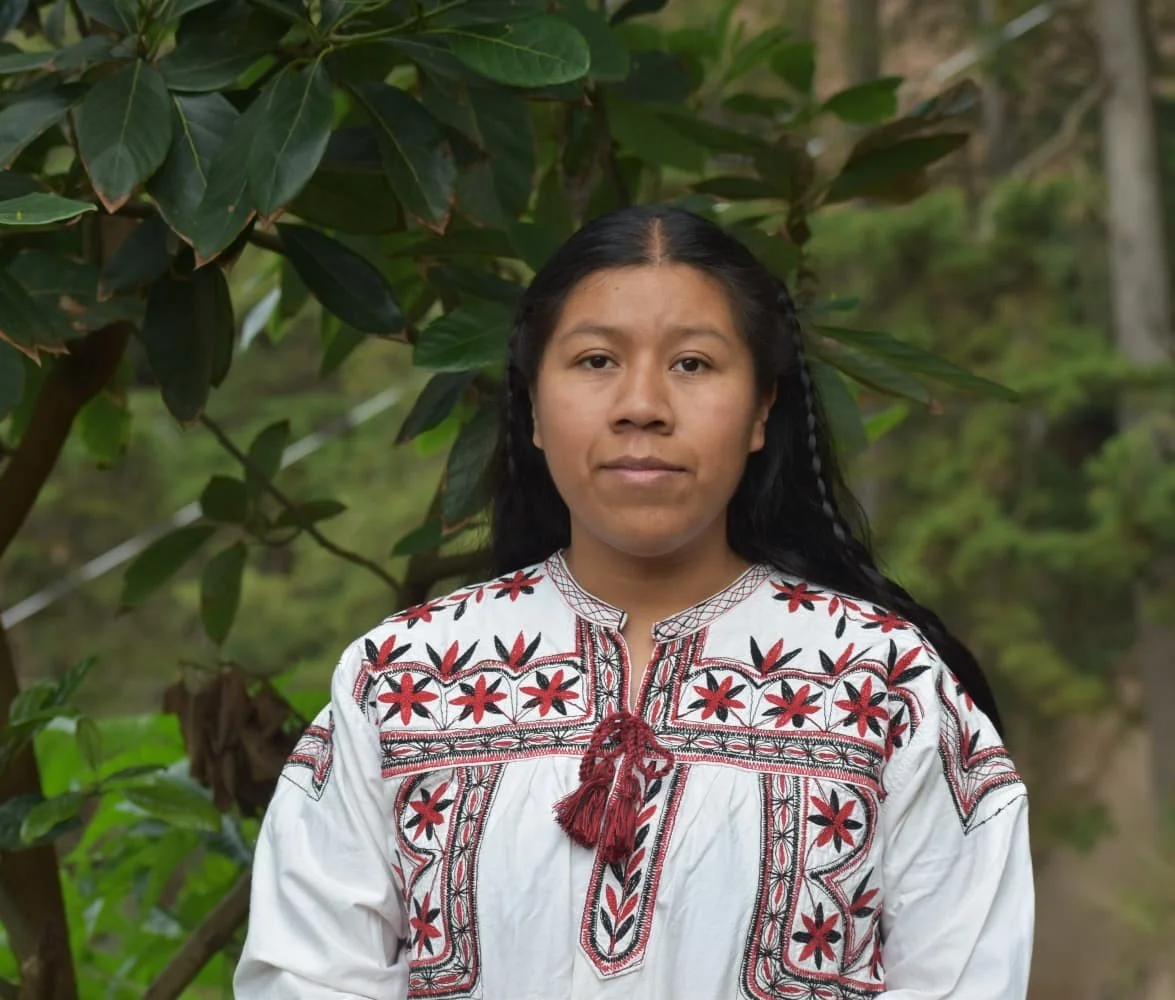Balance of the first week of COP30 / Balanço da primeira semana da COP30
Authors: Collective of Indigenous Women and Youth, and Mestizo Women
Read the article in English or in Portuguese below the photos
1. Belém, COP30 territory
The intensity of a COP is, in itself, a factor to consider. However, holding a climate COP in the heart of the Amazon is on another level. Belém, capital of the State of Pará, has a persistent history and frequently leads deforestation in the Legal Amazon, in terms of absolute deforested area, between 2019 and 2024 (MapaBiomas). It is also the scenario where looks, interests, disputes and hopes about the future of the forest are concentrated. With a population of about 1.3 million inhabitants, Services and Information in Brazil, the city already feels, in its body and in its daily life, the effects of climate change: intense and muggy heat, heavy rains, flooding, congested traffic and deep socio-spatial inequalities.
At the same time, Belém expresses the strength of Amazonian miscegenation: a diverse cuisine (açaí, fish, duck in tucupi, tacacá), a living culture that mixes indigenous, black and European matrices, urban landscapes that take your breath away not only for the climate, but for the beauty, and a warm, generous and proud population to host COP30 in its territory. Pará is known for being the world's largest producer of açaí, for being home to a large part of the Brazilian Amazon and for extending to Marajó Island, famous for buffaloes and Marajoara ceramics. The name "Pará" comes from the Tupi-Guarani pa'ra, "river-sea", reminding us that here the boundaries between river and ocean, land and water, city and forest are always fluid. In this context, holding COP30 in Belém is not a detail: it is a political and symbolic choice, in which the forest itself is present every day, in the afternoon, with its torrential rains that often make speeches inaudible for a few minutes. To talk about climate, nature and anthropogenic changes is to talk about the Amazons, their peoples, and how close we are to their tipping point.
2. Views of the negotiations
The Indigenous Peoples Caucus, and the Brazilians representation in Belém constitute a historic and diverse group at the Brazilian delegation. Their demands revolve around collective reflections that have the principle of the 7th generation (in which decisions must consider their impacts in up to 7 generations) as central and beyond:
the recognition of indigenous territories as a climate solution;
direct funding for peoples and communities;
the demarcation and effective protection of lands;
full and effective participation in decision-making spaces;
respect for their worldviews;
more seats in official delegations;
participation in the definition of agendas;
power of voice and vote in decisions that directly affect their territories.
This group operates both within the Blue Zone and Green Zone and in alternative and self-managed spaces in the city, such as the so-called COP30 Village, People's COP and People's Summit, which welcome and articulate a large number of Indigenous Peoples, Quilombola and Traditional Communities, social movements and allies who do not have access to the official negotiation area. Despite the historic Indigenous presence, celebrated by the Minister of Indigenous Peoples, Sonia Guajajara, at the opening of the Brazilian Pavilion on November 10, the barriers to access remain evident.
The estimate is that about 3,000 indigenous representatives come from different parts of the world, but only about 14% (360 people) have accreditation for the Blue Zone, where there is also an Indigenous Peoples Pavilion. This inequality of access reveals a central contradiction: the peoples who most protect the forest still have a limited presence in the spaces where their future is decided. Additionally, it is essential to note that the indigenous movement is not a homogeneous entity. In Brazil alone, there are about 400 ethnic groups and the plurality of voices and positions was evident in the actions of the first week. On the second day of COP30, indigenous people and allies held a protest, in which they entered the Blue Zone, demanding greater representation and real participation in the negotiations. The Munduruku People staged another demonstration in front of the Blue Zone, demanding a meeting with President Lula to discuss the situation of their territories. After hours under the strong sun, leaders were received by the president of COP30 and ministers Sonia Guajajara (Indigenous Peoples) and Marina Silva (Environment).
In a speech at the beginning of 2025, Marina Silva recalled that a COP "is not a party, it is a struggle. It's not the World Cup, it's not the Olympics." She described this moment as a "pedagogy of mourning and pain", marked by the threat to multilateralism, solidarity and collaboration between peoples. This pedagogy is also present in indigenous bodies and voices that, even in the face of fatigue, continue to demand demarcation and climate justice.
5. From the perspective of Wilses Tapajós
Indigenous doctor, Cobra Grande territory, within the territory called Brazil
"This is my first COP. I felt 'recognized' by the public call, recognized in the sense of hearing: 'we want you at the COP, you can help'. I will stay the two weeks and I can say that I will leave COP30 differently, due to the amount of content about the climate crisis and because, through them, I find myself as a doctor in the relationship between climate and health. I always knew, from experience, that climate and health have everything to do with each other, but I lacked a more solid foundation, data and technical language; Here I am finding it. As an indigenous person, however, the feeling is dubious. If managers, ministers, presidents recognize that we, indigenous peoples, protect the forests, risking our lives to defend our territories, why are our lands not yet demarcated? My territory, Cobra Grande, is not large: we are about 500 indigenous people, 150 families, but the demarcation process is stopped at the stage of physical delimitation; at FUNAI they told us that there are no resources to continue, and so we continue to be exposed to the fury of non-indigenous people, to invasion, to violence.
The more protected and demarcated indigenous territories are, the greater the chances of our population growing safely. At a time like COP30, our dream is that there is a strong and clear recommendation for demarcation now, and that this really happens. More demarcated lands mean more people taking care of the forest, more standing forest and more concrete contribution to facing the climate crisis, in addition to being one of the steps towards our well-being, as we also fight for education, health, safety and transportation.
The presence of many indigenous people at the COP brings hope to qualify this debate and strengthen positive changes. I wonder how many of us will come out of this COP30 empowered and how this can contribute to more dialogues, changes and the presence of more indigenous people in the management of this country. The climate crisis has shaken the world, something that we, Indigenous Peoples, have been announcing for a long time. But, in fact, COP30 brings hope, knowledge, empowerment and dreams. I am happy to participate in this global climate struggle because, in a way, it relates to our demands: to keep the forest standing, rivers alive, fauna and flora intact, and thus prevent the destruction of this planet."
6. From the perspective of Esther Martínez Ayuujk
Young Ayuujk, a member of the Ayuujk Poj Kaa Women's Organization, a territory called Oaxaca, Mexico.
“The presence of sister nations at COP30 becomes a collective force that supports and shelters. However, repression, lack of access, and the fact that our voices are ignored or that we lack a seat at the negotiating tables foster rage and anger in both mind and body. Indigenous communities are met with disdain, restrictions, fences, weapons, and soldiers, just as they arrive in our territories. They strip us of our ways of life and destroy our Mother Earth, as well as our bodies. From birth, the capitalist, patriarchal, and colonialist system subjects us to violent and invasive health institutions; women are used as birth machines for their system, torn from our land. We want to be born with dignity in our land. Justice for women and their bodies is also climate justice, women are the first territory to be defended.
Because women, young people, and girls are guardians of seeds and knowledge, we communicate with the land, the hill, and the web of life to harvest food from the milpa. In these times, this has become an exhausting struggle, a struggle for survival, due to the drought of our soils, changes in precipitation patterns, pests, diseases, agrotoxics, transgenic seeds, and companies. They make the continuity of the milpa no longer viable; that is what they are seeking, to make us lose food sovereignty and become dependent on their unsustainable production systems.”
Thanks to our grandmothers and grandfathers, we know that our land is the most valuable thing that exists; we will not abandon it. Instead, we adapt and evolve with it in response to climate change and the extractivist system. Every seed I care for and preserve is and will be food for my daughters and future generations, enabling them to continue evolving and living as Ayuujk people. We want them to stop perceiving us as objects and merchandise. It is unjust that we bear the responsibility of preserving our forests in exchange for our lives, when it is the extractivist system that destroys them. We seek justice and a dignified life for ourselves and our territories. We are the diversity of Mother Earth; the continuation of our lives depends on the web of life.”
The week ended on Saturday with a Global March through the streets of Belém, gathering around 70,000 people who expressed, among other things, that the Amazon and its peoples would truly be heard by those negotiating their futures. On Sunday, the autonomous People’s Summit, delivered its final declaration stating that the capitalist mode of production, especially the power of transnational corporations and financial capital, is at the root of the climate crisis. The declaration, together with a letter from children, was handed to COP leaders and Brazilian authorities, with a commitment that it would be shared with country delegations in the official agenda.
This article was co-written by:
Taís Sonetti González, latina and mestiça researcher, based in the Global South. Focali member E-mail: tatasgonzalez@gmail.com
& Post-doctoral reseracher at Unicamp - AmazonFACE, resercher associated with Stockholm Resilience Centre
Wilses Tapajós, Indigenous doctor, Cobra Grande territory, within the territory called Brazil. E-mail: assicog@gmail.com Instagram: acaosaudeindigena
Esther Martínez Ayuujk, Young Ayuujk, a member of the Ayuujk Poj Kaa Women's Organization, a territory called Oaxaca, Mexico. E-mail: pojkaaac@gmail.com
Instagram: poj_kaa_
Article in Portuguese below the photo gallery with photos by Taís Sonetti González.
Balanço da primeira semana da COP30
Autoras: Coletivo de Mulheres e Jovens Indígenas, e Mulheres Mestiças
1. Belém, território da COP30
A intensidade de uma COP já é, por si só, um fator a considerar. Porém, realizar uma COP do clima no coração da Amazônia é de outro nível. Belém, capital do estado do Pará, tem um histórico persistente e, com frequência, lidera o desmatamento na Amazônia Legal em termos de área absoluta desmatada entre 2019 e 2024 (MapaBiomas). É também o cenário onde se concentram olhares, interesses, disputas e esperanças sobre o futuro da floresta.
Com uma população de cerca de 1,3 milhão de habitantes (Serviços e Informações do Brasil), a cidade já sente, no corpo e no cotidiano, os efeitos das mudanças climáticas: calor intenso e abafado, chuvas fortes, alagamentos, trânsito congestionado e profundas desigualdades socioespaciais.
Ao mesmo tempo, Belém expressa a força da mestiçagem amazônica: uma culinária diversa (açaí, peixe, pato no tucupi, tacacá), uma cultura viva que mescla matrizes indígenas, negras e europeias, paisagens urbanas que tiram o fôlego não só pelo clima, mas pela beleza, e uma população calorosa, generosa e orgulhosa de receber a COP30 em seu território.
O Pará é conhecido por ser o maior produtor mundial de açaí, por abrigar grande parte da Amazônia brasileira e por se estender até a Ilha de Marajó, famosa pelos búfalos e pela cerâmica marajoara. O nome “Pará” vem do tupi-guarani pa’ra, “rio-mar”, lembrando que aqui as fronteiras entre rio e oceano, terra e água, cidade e floresta são sempre fluidas.
Nesse contexto, realizar a COP30 em Belém não é um detalhe: é uma escolha política e simbólica, na qual a própria floresta se faz presente todos os dias, à tarde, com suas chuvas torrenciais que muitas vezes tornam as falas inaudíveis por alguns minutos. Falar de clima, natureza e alterações antropogênicas é falar das Amazônias, de seus povos e de quão perto estamos do seu ponto de não retorno.
2. Ponto de vista das negociações
O Grupo de Povos Indígenas (Indigenous Peoples Caucus) e a representação brasileira em Belém constituem um coletivo histórico e diverso dentro da delegação do Brasil. Suas demandas giram em torno de reflexões coletivas que têm como central o princípio da 7ª geração (segundo o qual as decisões devem considerar seus impactos em até sete gerações) e, para além dele, incluem:
o reconhecimento dos territórios indígenas como solução climática;
financiamento direto para povos e comunidades;
demarcação e proteção efetiva das terras;
participação plena e efetiva nos espaços de decisão;
respeito às suas cosmovisões;
mais assentos nas delegações oficiais;
participação na definição das agendas;
poder de voz e voto em decisões que afetam diretamente seus territórios.
Esse grupo atua tanto na Zona Azul (Blue Zone) quanto na Zona Verde (Green Zone) e em espaços alternativos e auto-organizados na cidade, como a chamada Vila da COP30, a COP dos Povos e a Cúpula dos Povos, que acolhem e articulam um grande número de povos indígenas, comunidades quilombolas e tradicionais, movimentos sociais e aliades que não têm acesso à área oficial de negociações.
Apesar da presença indígena histórica – celebrada pela Ministra dos Povos Indígenas, Sonia Guajajara, na abertura do Pavilhão do Brasil em 10 de novembro –, as barreiras de acesso permanecem evidentes.
A estimativa é de cerca de 3.000 representantes indígenas de diferentes partes do mundo, mas apenas 14% (360 pessoas) têm credenciamento para a Zona Azul, onde também há um Pavilhão dos Povos Indígenas. Essa desigualdade de acesso revela uma contradição central: os povos que mais protegem a floresta ainda têm presença limitada nos espaços onde se decide o futuro de seus territórios.
Além disso, é fundamental destacar que o movimento indígena não é homogêneo. Só no Brasil há cerca de 400 etnias, e a pluralidade de vozes e posições ficou evidente nas ações da primeira semana. No segundo dia da COP30, indígenas e aliados realizaram um protesto, entrando na Zona Azul e exigindo maior representatividade e participação efetiva nas negociações. O Povo Munduruku protagonizou outra manifestação em frente à Zona Azul, exigindo uma reunião com o presidente Lula para discutir a situação de seus territórios. Após horas sob o sol forte, as lideranças foram recebidas pelo presidente da COP30 e pelas ministras Sonia Guajajara (Povos Indígenas) e Marina Silva (Meio Ambiente).
Em uma fala no início de 2025, Marina Silva lembrou que uma COP “não é festa, é luta. Não é Copa do Mundo, não é Olimpíada”. Ela descreveu esse momento como uma “pedagogia do luto e da dor”, marcada pela ameaça ao multilateralismo, à solidariedade e à colaboração entre os povos. Essa pedagogia também está presente nos corpos e nas vozes indígenas que, mesmo diante do cansaço, continuam exigindo demarcação e justiça climática.
5. Na perspectiva de Wilses Tapajós
Médica indígena, território Cobra Grande, dentro do território chamado Brasil
“Esta é a minha primeira COP. Eu me senti ‘reconhecida’ pela chamada pública, reconhecida no sentido de ouvir: ‘Queremos você na COP; você pode ajudar’. Vou ficar as duas semanas e posso afirmar que sairei diferente da COP30, pela quantidade de conteúdos sobre a crise climática e por, por meio deles, me encontrar como médica na relação entre clima e saúde. Eu sempre soube, pela experiência, que clima e saúde têm tudo a ver, mas me faltava uma fundamentação mais sólida, com dados e linguagem técnica; aqui estou encontrando isso.
Como indígena, porém, o sentimento é dúbio. Se gestores, ministros, presidentes reconhecem que nós, povos indígenas, protegemos as florestas, arriscando nossas vidas para defender nossos territórios, por que nossas terras ainda não estão demarcadas? Meu território, Cobra Grande, não é grande: somos cerca de 500 indígenas, 150 famílias, mas o processo de demarcação está parado na etapa de delimitação física; na FUNAI nos disseram que não há recursos para continuar e, assim, seguimos expostos às fúrias dos não indígenas, à invasão, à violência.
Quanto mais protegidos e demarcados forem os territórios indígenas, maiores serão as chances de nossa população crescer com segurança. Em um momento como a COP30, nosso sonho é que haja uma recomendação forte e clara pela demarcação já – e que isso realmente aconteça. Mais terras demarcadas significam mais gente cuidando da floresta, mais floresta em pé e uma contribuição mais concreta para enfrentar a crise climática, além de ser um dos passos para o nosso bem-viver, pois também lutamos por educação, saúde, segurança, transporte.
A presença de muitos indígenas na COP traz esperança de qualificar esse debate e fortalecer mudanças positivas. Fico imaginando quantos de nós sairemos empoderados desta COP30 e como isso pode contribuir para mais diálogos, mudanças e para a presença de mais indígenas na gestão deste país.
A crise climática tem abalado o mundo, algo que nós, povos indígenas, já anunciávamos há muito tempo. Mas, de fato, a COP30 traz esperança, conhecimento, empoderamento e sonhos. Estou feliz em participar desta luta mundial a favor do clima porque, de certa forma, ela se encontra com nossas demandas: manter a floresta em pé, rios vivos, fauna e flora intactas, e assim evitar a destruição deste planeta.”
Wilses Tapajós, Indigenous doctor, Cobra Grande territory, within the territory called Brazil. E-mail: assicog@gmail.com Instagram: acaosaudeindigena
6. Na perspectiva de Esther Martínez Ayuujk
Jovem Ayuujk, integrante de Organização de Mulheres Ayuujk Poj Kaa, território chamado Oaxaca, México.
“A presença de nações irmãs na COP30 se torna uma força coletiva que sustenta e acolhe. No entanto, a repressão, a falta de acesso e o fato de nossas vozes serem ignoradas, ou de não termos assento nas mesas de negociação, alimentam a raiva e a indignação na mente e no corpo. As comunidades indígenas são recebidas com desprezo, restrições, grades, armas e soldados, da mesma forma como chegam aos nossos territórios. Arrancam de nós nossos modos de vida e destroem nossa Mãe Terra, assim como nossos corpos.
Desde o nascimento, o sistema capitalista, patriarcal e colonial nos submete a instituições de saúde violentas e invasivas; as mulheres são usadas como máquinas de reprodução para esse sistema, arrancadas de nossa terra. Queremos nascer com dignidade em nossa terra. Justiça para as mulheres e seus corpos também é justiça climática: as mulheres são o primeiro território a ser defendido. Porque mulheres, jovens e meninas são guardiãs de sementes e conhecimentos, nos comunicamos com a terra, o monte e a teia da vida para colher o alimento da milpa. Nestes tempos, isso se tornou uma luta exaustiva, uma luta pela sobrevivência, devido à seca de nossos solos, às mudanças nos regimes de chuva, às pragas, doenças, agrotóxicos, sementes transgênicas e às empresas. Fazem com que a continuidade da milpa deixe de ser viável; é isso que buscam: que percamos a soberania alimentar e passemos a depender de seus sistemas de produção insustentáveis.
Graças aos nosss avós e avôs, sabemos que nossa terra é a coisa mais valiosa que existe; não vamos abandoná-la. Em vez disso, nos adaptamos e evoluímos com ela em resposta às mudanças climáticas e ao sistema extrativista. Cada semente que cuido e preservo é e será alimento para minhas filhas e para as futuras gerações, permitindo que continuem a evoluir e a viver como povo Ayuujk.
Queremos que deixem de nos perceber como objetos e mercadoria. É injusto que recaia sobre nós a responsabilidade de preservar nossas florestas em troca de nossas vidas, quando é o sistema extrativista que as destrói. Buscamos justiça e uma vida digna para nós e para nossos territórios. Somos a diversidade da Mãe Terra; a continuidade de nossas vidas depende da teia da vida.”
A semana terminou no sábado com uma Marcha Global pelas ruas de Belém, reunindo cerca de 70 mil pessoas que expressaram, entre outras coisas, o desejo de que a Amazônia e seus povos sejam realmente ouvidos por quem negocia seus futuros. No domingo, a Cúpula dos Povos, evento autônomo, entregou sua declaração final afirmando que o modo de produção capitalista, especialmente o poder das corporações transnacionais e do capital financeiro, está na raiz da crise climática. A declaração, juntamente com uma carta das crianças, foi entregue à liderança da COP e às autoridades brasileiras, com o compromisso de que seria compartilhada com as delegações dos países na agenda oficial.
Taís Sonetti González, pesquisadora latina e mestiça, baseada no Sul Global.
E-mail: tatasgonzalez@gmail.com
Wilses Tapajós, médica indígena, território Cobra Grande, no território chamado Brasil.
E-mail: assicog@gmail.com | Instagram: @acaosaudeindigena
Esther Martínez Ayuujk, jovem Ayuujk, integrante da Organização de Mulheres Ayuujk Poj Kaa, em um território chamado Oaxaca, México.
E-mail: pojkaaac@gmail.com | Instagram: @poj_kaa_

